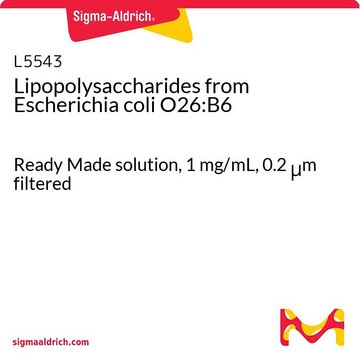L3024
Lipopolysaccharides from Escherichia coli O111:B4
purified by ion-exchange chromatography, TLR ligand tested
Sinónimos:
LPS
Iniciar sesiónpara Ver la Fijación de precios por contrato y de la organización
About This Item
Productos recomendados
biological source
Escherichia coli (O111:B4)
Quality Level
form
lyophilized powder
purified by
ion-exchange chromatography
impurities
<1% Protein
<1% RNA
color
white to yellow cast
solubility
water: soluble
shipped in
ambient
storage temp.
2-8°C
¿Está buscando productos similares? Visita Guía de comparación de productos
General description
This product is extracted from E. coli serotype O111:B4 and purified by ion exchange. The source strain is from a private collection. This LPS serotype has been used to stimulate B-cells and induce NOS in human hepatocytes.
Application
Lipopolysaccharides (LPSs) are characteristic components of the cell wall of Gram-negative bacteria. LPS and its lipid A moiety stimulate cells of the innate immune system by the Toll-like receptor 4 (TLR4), a member of the Toll-like receptor protein family, which recognizes common pathogen-associated molecular-patterns (PAMPs).
Biochem/physiol Actions
Lipopolysaccharides (LPS) are localized in the outer layer of the membrane and are, in noncapsulated strains, exposed on the cell surface. They contribute to the integrity of the outer membrane, and protect the cell against the action of bile salts and lipophilic antibiotics.
Preparation Note
The product is soluble in water (5 mg/mL) or cell culture medium (1 mg/mL) yielding a hazy, faint yellow solution. A more concentrated, though still hazy, solution (20 mg/mL) has been achieved in aqueous saline after vortexing and warming to 70-80 °C. Lipopolysaccharides are molecules that form micelles in every solvent. Hazy solutions are observed in water and phosphate buffered saline. Organic solvents do not give clearer solutions. Methanol yields a turbid suspension with floaters, while water yields a homogeneously hazy solution.
Other Notes
To gain a comprehensive understanding of our extensive range of Lipopolysaccharides for your research, we encourage you to visit our Carbohydrates Category page.
related product
Referencia del producto
Descripción
Precios
signalword
Danger
hcodes
Hazard Classifications
Acute Tox. 2 Oral
Storage Class
6.1A - Combustible acute toxic Cat. 1 and 2 / very toxic hazardous materials
wgk_germany
WGK 3
flash_point_f
Not applicable
flash_point_c
Not applicable
ppe
Eyeshields, Gloves, type N95 (US)
Elija entre una de las versiones más recientes:
¿Ya tiene este producto?
Encuentre la documentación para los productos que ha comprado recientemente en la Biblioteca de documentos.
Los clientes también vieron
Yoshitomo Hayama et al.
Journal of immunology (Baltimore, Md. : 1950), 200(11), 3790-3800 (2018-04-25)
Amino acid metabolism plays important roles in innate immune cells, including macrophages. Recently, we reported that a lysosomal adaptor protein, Lamtor1, which serves as the scaffold for amino acid-activated mechanistic target of rapamycin complex 1 (mTORC1), is critical for the
Carl-Fredrik Johnzon et al.
Frontiers in immunology, 9, 1487-1487 (2018-07-11)
Mastitis is an inflammatory condition of the mammary tissue and represents a major problem for the dairy industry worldwide. The present study was undertaken to study how experimentally induced acute bovine mastitis affects inflammatory parameters and changes in the metabolome.
Sharon Elazar et al.
Veterinary research, 41(1), 10-10 (2009-10-16)
Mastitis, inflammation of the mammary tissue, is a common disease in dairy animals and mammary pathogenic Escherichia coli (MPEC) is a leading cause of the disease. Lipopolysaccharide (LPS) is an important virulence factor of MPEC and inoculation of the mammary
F T Silvestre et al.
Journal of dairy science, 94(5), 2285-2301 (2011-04-29)
The objectives were to evaluate the effects of differential supplementation of Ca salts (CS) of fatty acids (FA) on plasma acute phase proteins and both FA composition and function (i.e., activity and cytokine production) of neutrophils, during the peripartum and
Simon N Willis et al.
Nature communications, 8(1), 1426-1426 (2017-11-12)
Humoral immunity requires B cells to respond to multiple stimuli, including antigen, membrane and soluble ligands, and microbial products. Ets family transcription factors regulate many aspects of haematopoiesis, although their functions in humoral immunity are difficult to decipher as a
Nuestro equipo de científicos tiene experiencia en todas las áreas de investigación: Ciencias de la vida, Ciencia de los materiales, Síntesis química, Cromatografía, Analítica y muchas otras.
Póngase en contacto con el Servicio técnico



